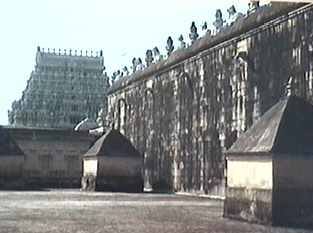The
name Tyagaraja is probably the best known of all in Karnatic Music
Circles. It is the name of the most prolific of the trinity of Classical music. There is
hardly a Karnatic music concert today not featuring compositions of this saint composer
Tyagaraja.
In the world of tamil films, MKT - or M. K. Tyagaraja
Bhagawatar who dominated the world of early black and white films also bore the
name Tyagaraja. In fact Tyagaraja is a commonly borne name in the Tamil speaking
region of the Indian subcontinent.
Perhaps many may not be even aware of the fact that the
afore-mentioned celebrities were named after the dominant deity in the now modest temple
town of Tiruvarur in the fertile Kaveri basin near Thanjavur and Nagappattinam.
Tyagaraja or Somaskandar
(Shiva) is the dominant deity of the Tiruvarur temple complex as well as
the 6 other Vitanka stalams in the
district. The Kamalambal shrine is regarded as one of the Shakti peethams
of India.

The Tiruvarur temple is steeped in
mysticism. The Vanmikanathar shrine
is amongst the oldest of Saivite shrines in Tamilnadu. The Tyagaraja shrine (representing Somaskanda) is
of great significance.The Somaskanda (Shiva
with his wife Uma and son Skanda) manifestation of Shiva is a representation of fertility.
The temple is rich in legends, tradition and literary wealth.
The saints of the
past millennium have sung its glory in no mean terms. Several miracles are associated with the saints
whose lives were intertwined with Tiruvarur.In the days of Cholas of
early 2nd millennium CE that this temple was the center of culture in Tamilnadu. Even during the the 1st millennium CE,
during the period of the Nayanmars, Tiruvarur
was a center of great festivities centered around the temple.
In its current state, it is a sprawling
temple complex with regal bearings, bearing silent signs reflecting a past
that exhuded grandeur. An atmosphere of quietude reigns where paegantry and festivities
were the daily norm. A skeletal temple staff carries out the day to day duties of temple
administration where once hundreds filled the space each day.
Barring festival days, this temple takes on the look of an
ancient vibrant institution now in a temporary state of hibernation.
The tell tale signs of its past grandeur are seen everywhere
- be it the well maintained corridors or the clean prakarams or the murals or the works of
sculpture. The Aazhitter, or the chariot in which the annual procession
of Tyagaraja is carried out is the largest of its kind in the country.
Be it the richness of legend,
tradition, patronage of the arts, association
with the Tamil Saivite Saints, or the
relatively more modern compositions of Muthuswamy Deekshitar (early 19th
century), the temple has it all.
Yet, little is known to Tamilnadu - leave alone the rest of
India, about this treasury of tradition-art-religion-culture-history all amalgamated in a
grand living monument that is the Tyagaraja temple complex at Tiruvarur.
It is with great pride that Templenet brings out this
long-delayed comprehensive electronic feature on this temple par excellence.
